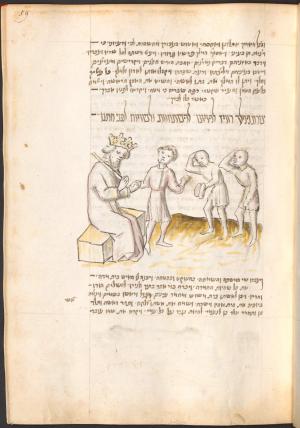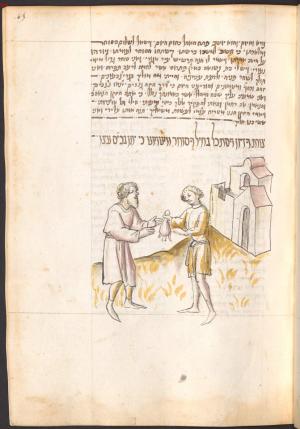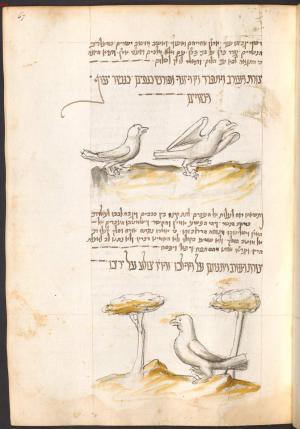Obj. ID: 21806
Hebrew Illuminated Manuscripts Munich Meshal ha-Kadmoni, Southern Germany, before 1458

Our manuscript is a miscellany of treatises which includes at its beginning the book Meshal ha-Kadmoni by Isaac ibn Sahula, composed inSpainin 1281. It was copied with five other treatises, philosophical, medical and polemical, by two main scribes, Scribe A-Abraham, and Scribe C-Jacob, with Scribe B writing least, for an unknown intellectual patron.
Meshal ha-Kadmoni is the only illustrated part of the manuscript, except for Sefer ha-Nizzahon (Book of the Triumph) which has some decorated space fillers and catchwords by Jacob, Scribe C.
Our manuscript has one of five early illustrated copies of ibn Sahula’s Meshal ha-Kadmoni, if not the earliest. They were all produced during the second half of the fifteenth century, two in south Germany in the 1450s: our manuscript (Munich Cod.heb. 107; Gronemann 2006, I:8-9; 60-66) and one in Oxford ('Oxf.1'; Bodl. Lib. MS Opp. 154), dated 1450 (fol. 59v), probably fromUlm (Gronemann 2006, I:8; 52-60). Three other copies were produced in northItaly between 1470 and 1491: one housed inOxford ('Oxf.2'; Bodl. Lib.MSCan. 59; Gronemann 2006, I:9; 67-71); another inMilan ('Milano'; Ambrosian Library, MS X 112 Sup.), dated 1483 and localised inBrescia (fol. 80; Gronemann 2006, I:10; 71-74); and the fifth manuscript is the Rothschild Miscellany in Jerusalem ('Rothschild'; IM MS 180/51), produced in the Veneto after 1470 (Gronemann 2006, I:9-10; 78-109). There are also two incunabula (1491, 1497/8) and many printed editions (Gronemann 2006, I:7).
The five manuscripts are not identical. The text of each story is divided into several episodes which follow similar basic patterns with some variations. The depictions largely follow a uniform iconography and composition and are mostly at the end of the episodes, dictated by the caption or the respective text, but each copy is rendered in a completely different style. Gronemann shows (2006, I:32, 50-51) that the text and titles for the illustrations appearing in the north Italian group of Meshal ha-Kadmoni (Oxf.2, Milano and Rothschild) are based either on our manuscript or, more probably, on a similar copy which transferred this genre from Germany to Italy, since our manuscript apparently never left Germany (see History). For more about the text see Loewe (2004:cxi-cxix).
It is hard to tell whether Ibn Sahula’s original copy included illustrations since no copy has survived from his days or later fromSpain, although in some places in the text the author refers to the astronomical diagrams (fols. 81v, 83, 85, 87v, 89). In any case, there is no way to reconstruct the hypothetical Spanish copy and therefore Gronemann suggests that the 15th-century Ashkenazi illustrations are a new departure which includes up to 85 illustrations (Gronemann 2006, I:29).
The 84 pen-drawn illustrations of Meshal ha-Kadmoni in our manuscript lack 4 scenes (Gronemann 2006, II:Table 4b, lines 19, 20, 22, 62). The illustrations are placed in the centre of the text space below the captions which describe them. They were executed by one artist in greyish-black ink over plummet underdrawings, except for two (fols.1 and 50) by Scribe A, Abraham, who also corrected some depictions in brown ink (see Decoration Programme) and probably executed some of the underdrawing (e.g. fols. 29v, 43). The illustrations present human and animal imagery in different configurations, compositions and postures (fols. 46v, 47v, 70, 71v, 74), in a yellowish-grey landscape and arranged in open and symmetrical compositions.
The empty spaces breaking the text column into three (fol. 3), or the large spaces left between text, captions and illustrations, suggest that the captions and illustrations were added after the writing was done.
Robert Suckale suggested that our manuscript was produced in Regensburg in the workshop of the Viennese Martinus Opifex who worked for a while in Regensburg (Suckale 1987:109-110); and further suggested that the cursory and minimal rendering of the illustrations pointed to their being just preparatory drawings (Vorzeichnungen) awaiting completion. Both contentions were later refuted by Simona Gronemann (2006, I:61, 143-150).
Gronemann shows that the style of illustrations in our manuscript is very close to a group of manuscripts from southern Germany, perhaps Swabia, especially to two copies produced in Augsburg in the 1440s: Der Edelstein by Ulrich Boner, Augsburg 1447 (Heidelberg Universitätsbibliothek, MS cpg.314) and a Calendar, c.1457, from Augsburg or Regensburg (Berlin, Staatsbibliothek Preussischer Kulturbesitz, MS mgf. 557).
Together withMunich, these two manuscripts share a seemingly cursory style, shaky lines and scanty thin wash colouring. The figures are voluminous and animated and some of them display extreme gestures. They have large hands and the facial features are minimally rendered with high forehead, closed eyes drawn as two inverted loops, the nose a vertical line with a short horizontal one, and the lips marked by two slightly undulating lines, the upper longer than the lower (Gronemann 2006, I:144 and comparisons II:figs. 34-48). The style suggestsAugsburgas a possible place of production for the illuminations of our manuscript around 1450 but before 1458, when the owner recorded the birth of his firstborn son (fol. 204v; see History). However, since Jews were expelled fromAugsburgin the year 1438, the manuscript could have been produced before that, or if later, then nearby, perhaps inRegensburg(Gronemann 2006, I:243).
sub-set tree:
Sixteenth-century brown sheepskin on cardboard decorated with gold stamped floral motifs in the centre and corners. The spine is decorated with similar floral motifs and has four double cords and head and tail bands.
The binding was probably done in the workshop of the court binder Heinrich Peisenberg in Munichfor Duke Albrecht V (cf. EBDB: w003886 for the centre motif and w003886 for the corner motif; Schunke 1958/60:721ff.):
|
Floral motif (EBDB: w003886) |
Floral motif (EBDB: w003886) |
Watermarks of the flyleaves: Piccard, Nos. 152921 (Munich 1562) and 24105 (Munich 1578):
|
Front flyleaf |
Back pastedown |
The Artist and Scribe A, Abraham (fols. 1-94v):
The 80 illuminations of Meshal ha-Kadmoni were executed by one artist, first in plummet and then in dark greyish ink, except for fols. 1 and 50, which were decorated by the main scribe Abraham in brown ink. The figures are economically yet voluminously rendered in shaky black ink outlines over a sketchy plummet drawing which delineates compositions and postures (e.g. fols. 46v, 47v, 70, 71v, 74). The shaky outlines were mostly overdrawn in bold black lines, and the illustrations coloured in grey, yellow ochre and magenta wash.
Following the illuminations, Scribe Abraham corrected some depictions in brown ink, but also did some underdrawings, which the artist overdrew in black ink (e.g. fols. 29v, 43). Abraham the scribe added details such as a lion's mane (fol. 9v), roof tiles (fol. 16v), a beard to indicate an old man (e.g. fols. 22, 55v) and headgear (fols. 33, 55v). He added pupils to down-cast eyes (e.g. fols. 22, 33, 55v, 73, 79), table-ware (fol. 55v), and branches with leaves to trees (fols. 29v, 33v). Indeed, the style of the added leaves (fol. 29v) is similar to those marking the name Abraham (fol. 66), thus divulging his hand.
Moreover, Abraham was not shy in correcting compositions and details which clarify the story or caption. For example, he changed the image of a woman to a man in accordance with the text (fol. 42), added a fifth astrologer on the right of the scene (fol. 79), changed the posture of figures and added identifying attributes (fols. 29v, 43). He covered a crown and other details with silver powder (fol. 33v) and added inscriptions in open books held by the figures (e.g. fols. 22v, 68, 73, 92v), a donkey's saddlebag and astronomical drawings
(fols. 81v, 83, 85, 87v, 89).
1. 75 text illustrations for Meshal ha-Kadmoni within the text space, mainly by the artist with additions by
Abraham, sometimes occupying more than half a page (fols. 3v, 4, 4v, 5v, 6, 7, 7v, 8v, 9, 9v, 11v, 13, 14,
15v, 16, 16v, 17, 17v, 18v, 19v, 20v, 22, 22v, 23v, 24, 25, 27, 28, 29v, 30v, 33, 33v, 34, 36, 38, 38v, 39,
41v, 42, 43, 44v, 46, 46v, 47v, 48, 50 (by Abraham), 52, 52v, 53, 54v, 55v, 56v, 57v, 59, 59v, 60v, 62,
65, 67, 68, 69, 70, 71v, 73, 74, 75, 76v, 77v, 79, 79v, 80, 88, 90, 91, 92v).
2. Five astronomical diagrams by Abraham illustrating the text (fols. 81v, 83, 85, 87v, 89).
3. Decorated initial words by Abraham for some sections of the text (e.g. fols. 1, 19, 41v, 52), the first
enclosed within a panel (fol. 1); some ascenders (e.g. birds' heads, fols. 53v, 55v, 91) and descenders
(e.g. fols. 49, 53) of letters are decorated by the scribe Abraham.
4. Shaped text by Abraham in geometrical forms at the end of sections and sub-sections (e.g. fols. 6v, 11,
12v, 13v, 30, 35v, 51v, 64v, 80v, 82v, 84, 86v, 87), two in the form of a jar (fol. 88, 88v), at times
surrounded by decorative borders (e.g. fols. 80v, 93v, 94).
5. Catchwords by Abraham are framed and decorated with tendrils (fols. 7v, 41v, 56v, 64v).
6. Decorative space fillers by Abraham (e.g. fols. 69v, 76v, 90v).
7. Abanner inscribed by Abraham with the word ניצחון (Triumph) on fol.103 inthe inner lower margin,
for the Book of the Triumph.
By Scribe C, Jacob:
1. Zoomorphic space fillers within the text space (fols. 149, 159).
2. Decorated catchwords, some zoomorphic, including perhaps a literal one of a ghost (e.g. fols. 117v
"השדים יכולים" 149v), and a dog (fol. 197v).
3. A pointing hand by the scribe (e.g. fol. 140).





















